Salvador Dali – David Alfaro Siqueiros and the Modernist Period
As some of you already know I am attending in a photography course in England which so far goes well and it is very interesting because every time we learn something new and our tutors Martyn Pearson and Richard Peregrine are very supportive with loads of knowledge!!!
I feel that without them I would not be able to achieve my very good grades in year one! That is why I would like to thank both of them even if they will never see this article!
So…back to this article now,
I thought that maybe would be a good idea to show you one of the assignments that we should complete in the contextual studies and maybe by this way I could help some other students to get ideas for their assignments or maybe to enrich other people knowledge about Modernism. The assignment was about to compare two artists and speak about the different movements and developments in 20th-century art.
My pick was to compare two paintings between two “different” practitioners. The Spanish surrealist Salvador Dali and the Mexican muralist David Alfaro Siqueiros.
The comparison of the paintings that you are going to see today is the “Espana” (Spain) by Salvador Dali and the “Echo of scream” by David Alfaro Siqueiros. Also, we will have a quick look at the most important movements ( in my opinion at least) in the modern period and we will speak a little bit about the artist’s lives.
Let’s start then…
Modernist Movements (1870 – 1980)
People are always trying to develop and find new ways to express themselves. Until 1760 the expression in art was a bit limited by the patronised traditions that artists established by the time. After the industrial revolution (1760-1840) which began in Great Britain, almost everything changed; New techniques and technologies in chemical manufacturing, hand production to machinery, paved the way for change in cultural forms and art. Some artists rebelled on this as they thought new technology was destroying a nostalgic, beautiful, traditional heritage. Others grabbed the chance to rebel against the traditions. The Modernism Period stated.
“It is only the modern that ever becomes old-fashioned.” (Oscar Wilde, 1854-1900)
Modernism influenced by the Industrial Revolution is a radical period in which people started to look the world in a different way. By breaking the traditional patrons and trying to find new forms of expression. The term modernism is widely used to describe a board of many political, cultural and artistic movements (Fig.1, Fig.2) between 1850 and 1960 mainly in Western society and Europe experimentation and individuals flourished. It was the one dominant ideologies of the 20th Century to affect many cultural forms such as; photography, media, design, architecture, literature and continues to influence artists from different areas of arts.
“By ‘modernity’ I mean the ephemeral, the fugitive, the contingent, the half of art whose other half is eternal and immutable…This transitory, fugitive element, whose metamorphoses are so rapid, must on no account be despised or dispensed with.”(Charles Baudelaire; From The Painter of Modern Life. 1863)


Impressionism was considered the first movement in painting, in the modern period which began approximately in 1860 in Paris by Claude Monet (1840-1926) and other French artists. Impressionism was characterised by the bright and vibrant colours in the paintings, and usually, most of them are outdoor scenes. They prefered to work outside as they found that they could capture the short effect of sunlight by working quickly in open air (En Plein Air). [1]
<<<[1] The French term “plein air” means out outdoors and refers to the practice of painting entire finished pictures outside.>>>
Some of the best impressionist artists were Auguste Renoir (1841-1919) and Paul Cezanne(1839-1906). Paul Cezanne founded the Post-Impressionism movement approximately between 1886 and 1905, which was the rebel of the Impressionist’s limitations of personal style and expression. Some of the supreme post-impressionists were Vincent Van Gogh (1853-1890) and Paul Gauguin (1848-1903). The strong and vibrant paintings of Van Gogh became the indication of Fauvism and Impressionism.
One of the most radical revolutionary movements was Cubism which pioneered by Pablo Picasso (1881-1973) with “Les Demoiselles d’Avignon” (1907) (Fig.3) and Georges Braque (1882- 1963) with “Houses of l’Estaque”(1908)(Fig.4) paintings around 1907. It was the first abstract style of the modern period and was primarily influenced later by Paul Cezanne’s three-dimensional work such as “Bibemus Quarry,” (1895) (Fig.5) which influenced Georges Braque, who painted the “Houses of l’Estaque”(1908)(Fig.4).
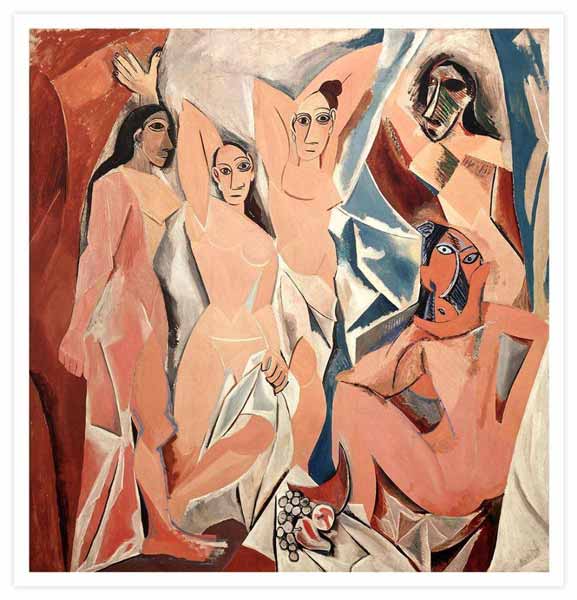
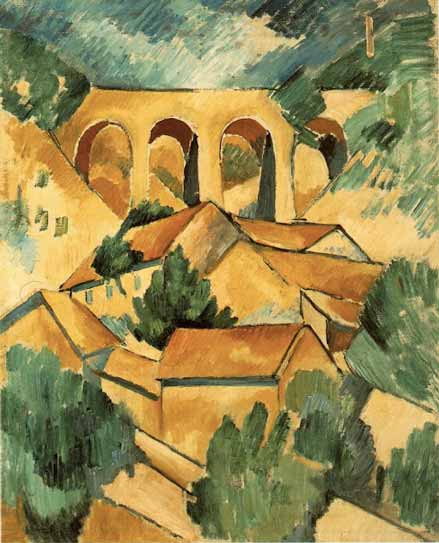
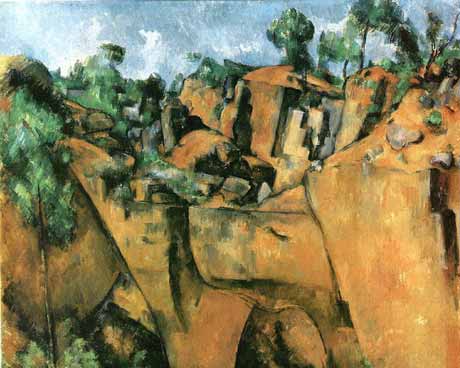
Picasso and Brague believed that the traditions of Western art had become exhausted. They started to transform everyday subjects such as; people and landscapes into geometrical shapes. Along with other cultures particularly African art (Fig.6), to refresh their work. It is believed that Cubism was the most influential movement in the 20th century[2] to inspire related movements in literature and architecture such as; Dadaism, Constructivism, Futurism, Suprematism, De Stijl and Art Deco.
All these movements were developed in response to Cubism.
Cubism influenced the Dutch painter Piet Mondrian (1872- 1944) who founded the De Stijl movement in 1917.
The Cubists goal was to introduce a new aesthetic, which could influence other forms of art such as music and poetry among them industrial design, architecture, urban planning and typography. The artistic philosophy of De Stijl was to use only straight lines and shapes by using primary colours, black and white (Fig.7)
Except for the impact on architecture(Fig.8), the abstract style of Cubism also influenced photography (Fig.9-11) and literature
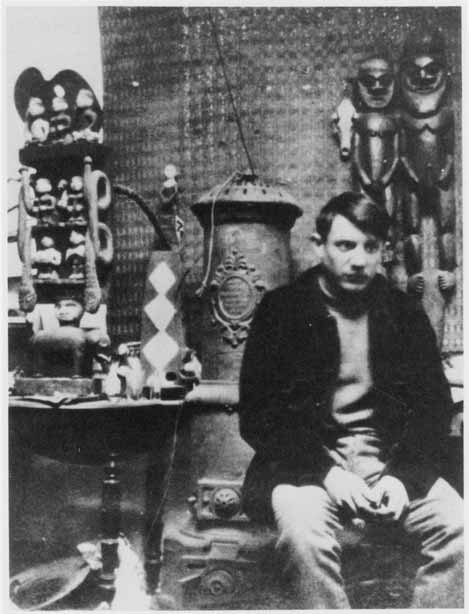
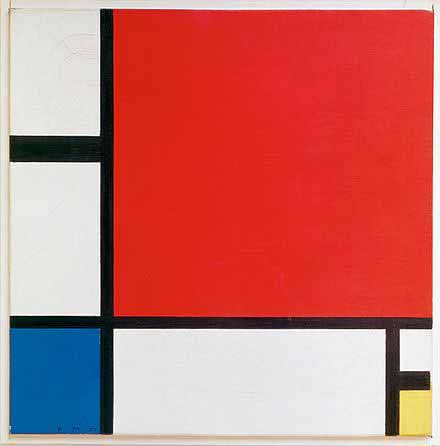
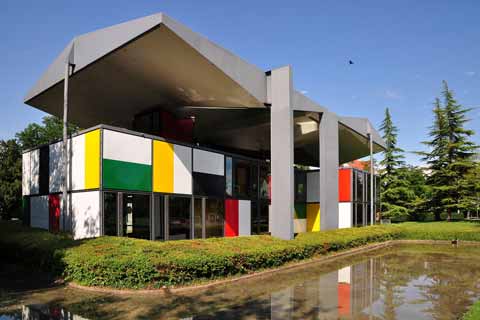
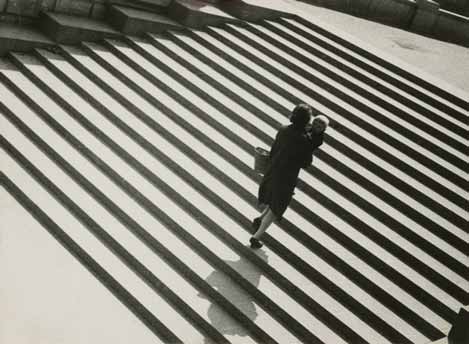
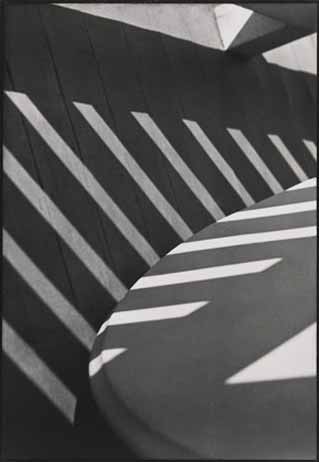
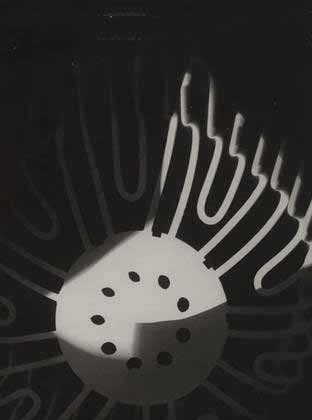
In 1917, a group of artists in Zürich, Switzerland created the Dada movement as a reaction to the First World War (1914-1918). This influenced many artists and Nationalism which many thought that led to the war. Dadaism was an “anti-art” (Marcel Duchamp,1913) group of people who rejected the aestheticism and logic and created irrational, nonsense and anti-bourgeois [3] protest in their works[4]. This movement could be seen almost in any forms. For example sound media, literary, cut-up writing(Fig.12).
Marcel Duchamp (1887- 1968), Max Ernst (1891- 1976) and Raoul Hausmann (1886- 1971), were between the best artists in Dada.
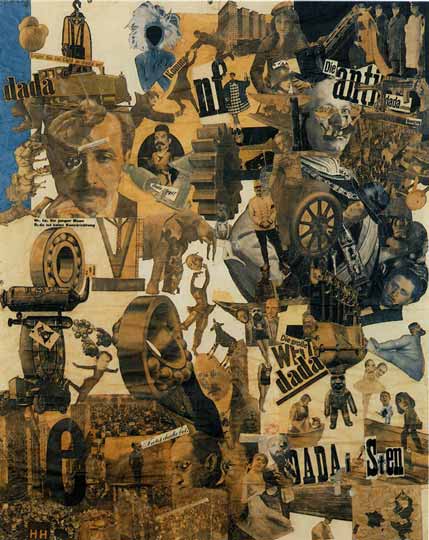
Later, Max Ernst become a member of the Surrealism art movement founded by Andre Breton in 1924 when he wrote “The Surrealist Manifesto[5].” Surrealists believed that by taping the subconscious, you could bring up the imagery of the rational mind which is the power of imagination. Sigmund Freud’s book “The Interpretation of Dreams” (1899) explains how important the dreams are and that the unconscious is connected with human’s emotions and desires. Salvador Dali, Max Ernst and Rene Magritte were the greatest Surrealists.
—————————————————————————————————————————————————————–
Footnotes:
[2] Green C., 2009 MoMA collection, Cubism, Introduction, from Grove Art Online, Oxford University Press,
Available from:
https://web.archive.org/web/20140813112047/http://www.moma.org/collection/details.php?theme_id=10068&displayall=1
[3] Bourgeoisie, the social order that is dominated by the so-called middle class. In social and political theory, the notion of the bourgeoisie was largely a construct of Karl Marx (1818–83) and of those who were influenced by him.
[4] Schneede, Uwe M. (1979), George Grosz, His life and work, New York: Universe Books
[5] A book that includes numerous examples of the applications of Surrealism to poetry and literature.
Salvador Dali ( 1904 – 1989)
Salvador Dali (1904 -1989) was raised in Spain where he started to experiment with different styles such as cubism, futurism, impressionism and Dada. In 1922 Dali attended a course at the San Fernando School of Fine Arts, in Madrid to study Sculpture, Engraving and Special Painting. Later he had met the filmmaker Luis Bunuel (1900- 1983) and the poet Federico Garcia Lorca (1898- 1936). Dali has been exposed by the school as one of the most important minds of the time such as Einstein, Stravinsky, Calder and Le Corbusier. But in 1926 before his final examination, Dali was Expelled from the academy for insulting one of his professors when he said that no one on the faculty was competent enough to examine him. The same year, Dali went on a trip to Paris, where he had met Pablo Picasso. He was inspired by the work the Cubists were doing and began studying the Psychoanalytic concepts of Freud and metaphysical painters like Giorgio de Chirico (1888- 1978) and surrealists like Joan Miro (1893- 1983). Dali began to use Freud’s methods of mining the subconscious to generate imagery. His first work with these methods was “Apparatus and Hand” in 1927 (Fig.13). In 1928, Dali worked with the filmmaker Luis Bunuel on “Un Chien Andalou “(An Andalusian Dog) (Fig. 14), a film with Irrational imagery and in 1928 was invited by Andre Breton to join the Surrealists.
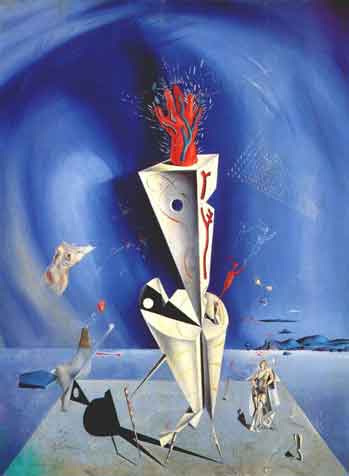
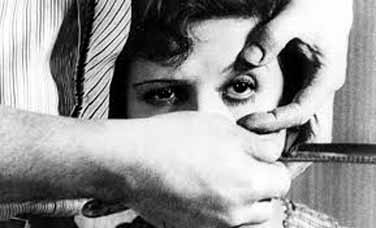
Salvador Dali created his method (Paranoiac-Critical Method)[6], simply put, it was a mental exercise of accessing the subconscious parts of the mind. It was a “paranoid” state, between sleep and awake. After coming back from this state, he was creating “hand-painted dream photographs”(Dali,1931).
In his 1930 article “The Rotting Donkey,” Dalí wrote:
“I believe that the moment is near when, through a process of thought of a paranoiac and active character, it will be possible to systematise confusion and contribute to the total discrediting of the world of reality.”
Most of his paintings can be recognised from the double-imagery that he uses through this method. Which contributed to his reputation as one of the best painters for his technical ability.
Dali believed that the subconscious is a universal language and that the viewers would find a connection through his work.
Here is what he said:
‘’The subconscious has a symbolic language that is truly a universal language, for it speaks with the vocabulary of the great vital constants – sexual instinct, feeling of breath, physical motion of the enigma of space – these vital constants are universally echoed in every human being. To understand an aesthetic picture, training in appreciation is necessary, cultural and intellectual preparation. For surrealism, the only requisite is a receptive and intuitive human being.’’ (in Levy, 1936).
He used this Method his entire life. Some of his most famous paintings using this method are “The Soft Construction with Boiled Beans (Premonition of Civil war)” in 1936 (Fig. 15), and “Metamorphosis of Narcissus” (1937) (Fig.16)
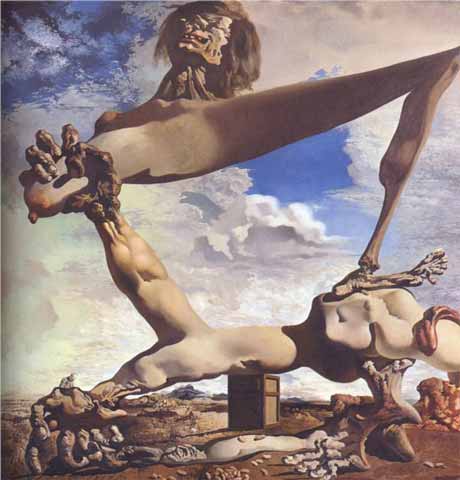
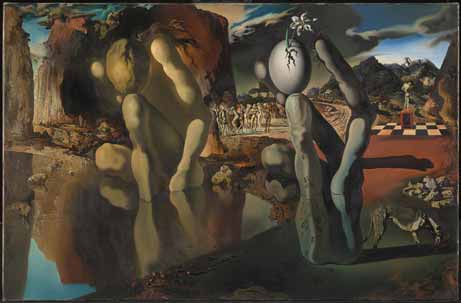
Spain had split apart in 1936 when the Spanish Civil War (1936–1939) started. Dali escaped with the fear of the war, and he moved to Italy when he began to study Raphael (1483- 1520), Leonardo Da Vinci (1452- 1519), and Michelangelo (1475- 1564). It is clear that the Renaissance masters influenced the artist in the groups of figures that he used to create multiple pictures in paintings like “Espana “(Spain) in 1938 (Fig.17).
—————————————————————————————————————————————————————–
Footnotes:
[6] Dalí described the paranoiac-critical method as a “spontaneous method of irrational knowledge based on the critical and systematic objectivity of the associations and interpretations of delirious phenomena.”(Salvador Dalí, 1976, p32)
Espana (Spain) 1938 by Salvador Dali
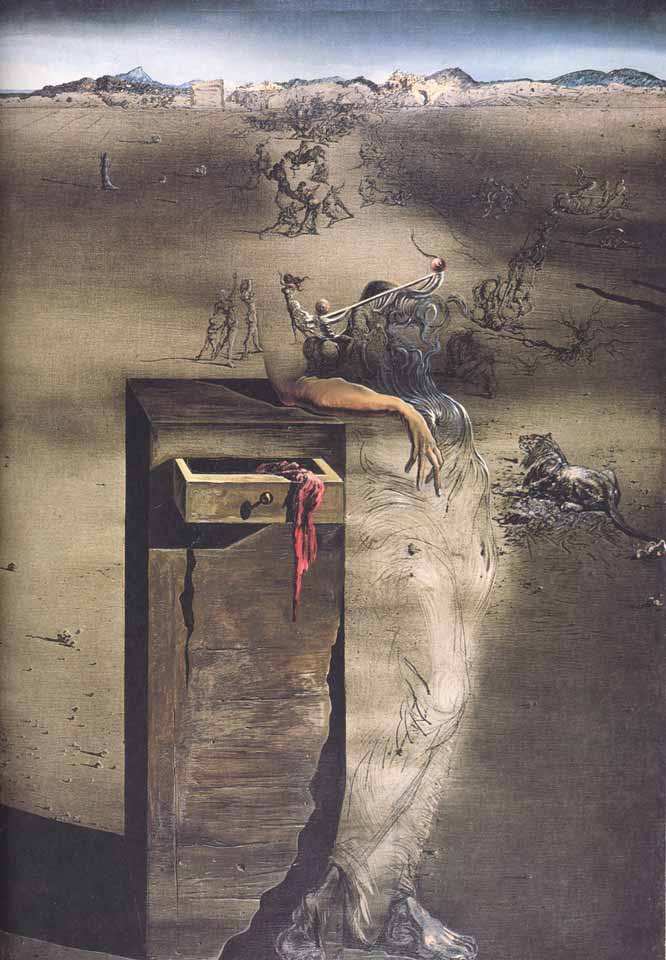
Espana is a surrealist oil on canvas painting in a vertical orientation with dimensions 91.8 x 60.2 cm, and It is saved in the Museum Boijmans van Beuningen, Rotterdam, Netherlands.
It is one of his finest and vital landscape paintings of Dali about the Civil War in Spain.
The first thing that grabs our attention is the sad overall feeling of the painting by watching the dull colours such as deep brown mainly at the sides of the frame. In the centre of the frame, there are human-shaped figures on horses and others on their feet, who are fighting each other and at the same time; because of their position, creating the face of the female figure, possibly the mother country, Spain. The character is leaning on a neglected cracked cabinet with an open drawer.
In the short Dictionary of Surrealism (1938), Dalí gives the following definition: “Wooden support derived from Cartesian philosophy Generally used to serve as support for the tenderness of soft structures.”
Also, drawers symbolise the memory and the unconscious[7]. They express the mystery of the hidden secrets. The red cloth hanging from the drawer is the only subject where the colour is vivid; the artist refers to the red of the blood of the brutal war. Next, to the right arm of the female figure, we can distinguish two adult human bodies, possibly a couple with a young boy who is holding the left hand of his father while his father raises his right arm to find help. Perhaps they felt despair, and that can be paired with another lonely female figure which can be described at the left top corner of the image. In the middle ground, we see a lion laying down on the ashes of the burnt woods, staring at the battle. The lion was a Freudian symbol of parental control and intimidation[8]. King of the Beasts is depicted in a position of superiority in all Dali’s paintings like “The Accommodations of Desire” (1929) (Fig.18). Espana is an excellent example of the double-image technique from Dali who tried to convey to the viewers. He combined the “Mother Spain” and groups of Renaissance warriors from the background – inspired by “The Battle of Anghiari” (1505) painted by Da Vinci (Fig.19) – in a way that she looks weak and fragile by giving her a ghost-like look. Also, he is showing us that she feels hopeless, hurt and disappointed by painting her in a way that she leans to the left to look down.
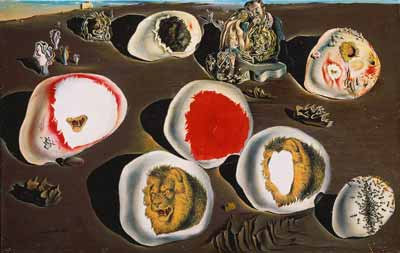
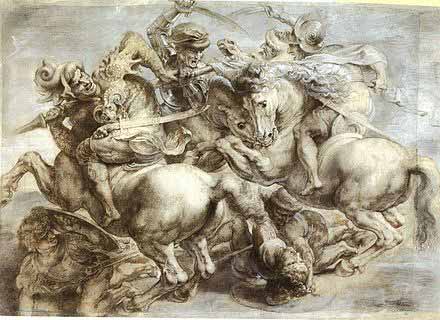
Many scholars compared “Espana” with “The Adoration of the Magi” by Leonardo Da Vinci (1481) (Fig.20) in which the central point is the Mother Mary as a foreground and in the background, warriors are fighting on the horses.
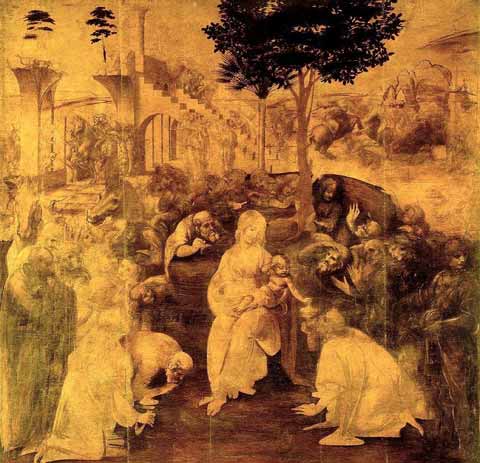
—————————————————————————————————————————————————————–
Footnotes:
[7] The drawers arise from their Freudian explanation as a representation of the concealed sexuality of women. Dalí portrays many of the drawers to be slightly ajar, indicating that their secrets are known and no longer to be feared.
Available from: https://www.thedaliuniverse.com/en/salvador-dali/symbols
[8] Lion is the symbol of male potency. King of the Beasts is depicted in a position of superiority in all Dali’s paintings. (The Accommodations of Desire, 1929) available from: https://arthive.com/publications/299~Dal_symbols_What_is_behind_them
David Alfaro Siqueiros (1896 – 1974)
David Alfaro Siqueiros (1896 – 1974) was an outspoken Mexican painter and political activist. He was one of the three greats of Mexican muralism; the other two were Diego Rivera (1886-1957) and Jose Orozco (1883- 1949). Well educated by Marxist ideology he dedicated his career to inform and inspire people for Revolution through his politically engaged art. Siqueiros mixed elements of avant-garde painting with folk and traditional art, along with historical symbolism.
When Siqueiros was four years old, his mother died, and his parental grandparents raised him in a small town of Santa Rosalia, Mexico. He studied art at the San Carlos Academy in Mexico, and the first signs of his political views were in 1911 when he participated in the student strike as he disagreed with the old-fashioned teaching methods of the school which led the head director of the school to resign. The result of this was to bring The Open-Air Painting School of Santa Anita, and the Mexican painter was one of the first students to enrol.
In 1914, David Alfaro travelled around Mexico with the Venustiano Carranza’s Constitutional Army by fighting against the Victoriano Huerta government. It was here that he discovered pre-Hispanic art and had also seen how Mexican labourers were living. These two experiences will have a significant impact on his later work.
Impressed by Cubism, Futurism and Italian Renaissance frescoes in 1919, whilst in Europe, Siqueiros visualised a new art where he started to mix modern significance and politics with traditions of painting. He was against the idea of new generations of artists who were influenced by European art, and he believed that they should break free from this and start to create work of their native traditions.
In 1922, Siqueiros returned to Mexico and started to create work, inspired by his Marxist beliefs, for the new revolutionary government but eight years later was forced to leave his country because of his radical politics. He went to Los Angeles and in 1936, travelled to New York where he ran a course where artists could experiment with the modern techniques in art. One of these was to place the canvas on the ground, and the painter should throw the paint on it straight from the tin. That was a new technique where the artist should use the entire body to create the work as a dance and Jackson Pollock[9] (1912- 1956) who was a student of Siqueiros dedicated almost his whole career on this technique. A technique that Siqueiros called ‘’controlled accident (Leonhard Emmerling, 2003, p14)’’
Before he started to fight with the Republicans against Francisco Franco’s fascist dictatorship in 1938, the Mexican painter painted one of his most iconic painting “Echo of A Scream” (1937) (Fig.21) which we will analyse next.
—————————————————————————————————————————————————————–
Footnotes:
[9] Jackson Pollock was an American painter and a major figure in the abstract expressionist movement. He was well known for his unique style of drip painting.
“Echo of a Scream” 1937 By David. A. Siqueiros
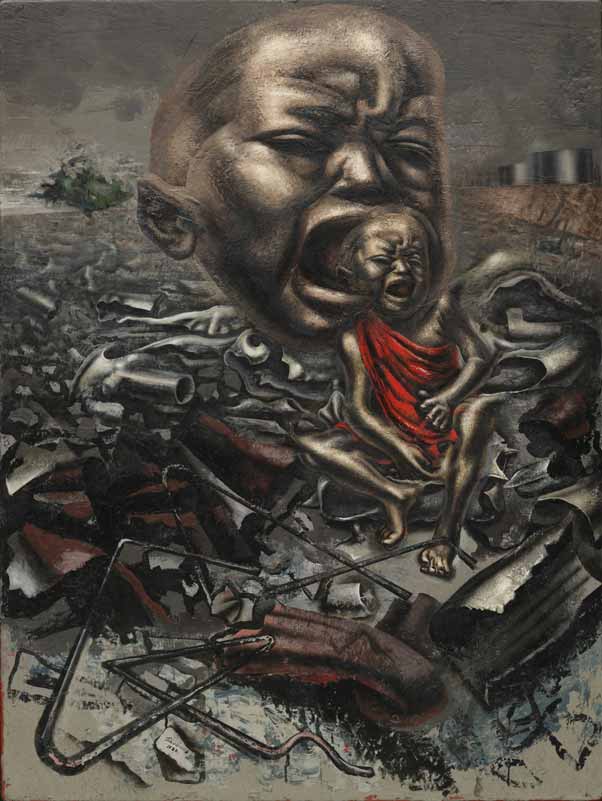
“Echo of a Scream” is surrealist enamel on wood painting rendered with use of pyroxylin by the Mexican muralist David Alfaro Siqueiros. It is in a vertical orientation with dimensions 121.9 cm x 91.4 cm, and it is saved in the Museum of Modern Art, in New York.
The painting depicts despair, destruction of war and the pain of human loss in the Spanish civil war (1936-1939). It is one of the most memorable images in the history of Mexican art. The most notable figure is a lonely, skinny, weak crying baby who sits on metallic scraps that look like a war zone. Armours and shrapnel surround him. The painter used dark colours such as black, grey, dark tones of red, brown and faded blush hues. The bottom of the frame to represents a dark and catastrophic period. He also used silver along with a rough and dirty texture to describe an industrial landscape which suffered from bombardments. Therefore Siqueiros ’s warmer tones on the boy along with the coloured tree to the left top corner, draw the viewers’ attention and shows us that there is hope, as these are the only two subjects that are still alive.
The scream of the baby corresponds to the scream of the title and just behind the boy is a more prominent face, that has the same expression as baby’s face. By doing this, the artist wants to show us the echo of his scream echoing into the empty, destroyed space. The most interesting fact is the that the echo is usually fading away, but in this painting, the artist draws a much bigger head than the original one which is almost covering the whole city, like the sorrow of the boy. The most vivid colour is red which belongs to the red clothing of the human figure. Possibly suggesting the bloodshed caused by the war; or perhaps indicates Communism (James Oles, 2011. P31).
What triggered my mind is that at the front plane, we can see a subject that it looks like a metal war identification plate which Siqueiros used to put his signature.
Siqueiros took the pose and the facial expression of the boy from a photograph by H.T Cowling (Fig.22), published in an article in National Geographic’s issue in February 1925. For him wasn’t difficult to notice this photograph, as he had an interest in this motif for a long time.

This can be seen from his earlier paintings including Proletarian Mother, (1930) (Fig.23) and Child Mother (1936) (Fig.24) Also, a connection can be seen between ‘’The Echo of a Scream’’ from Siqueiros and ‘’The Scream’’(Fig.25) from Edvard Munch in 1893 as they both have facial expressions but from a different angle.
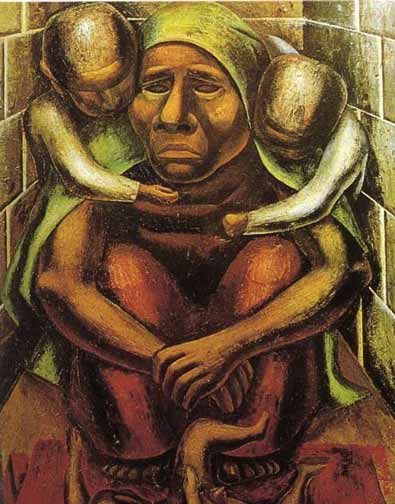
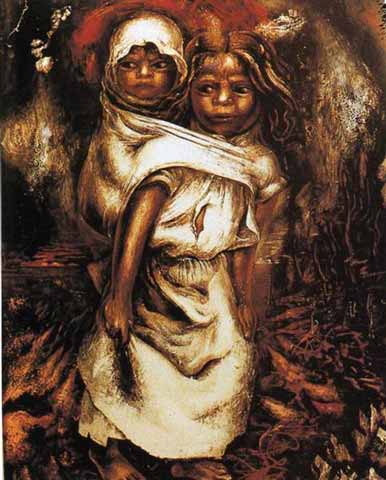
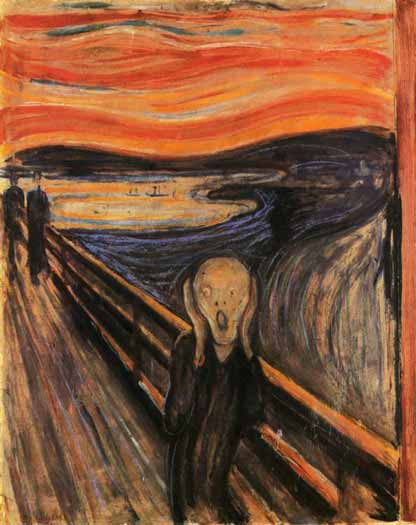
Siqueiros used to paint in a way that revealed hidden messages of wider political issues and not only feelings of personal angst.
“The artist must paint as he would speak. I don’t want people to speculate what I mean; I want them to understand.” (David Alfaro Siqueiros)
In fact, the scream is a topos commonly used to arouse viewers’ sympathy for a cause as in Sergei Eisenstein’s film Battleship Potemkin in 1925 (Fig.26) (James Oles,2011, p.32)
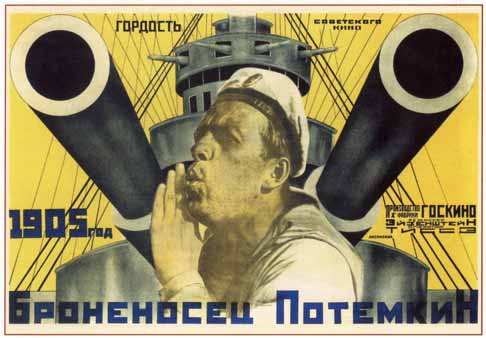
Conclusion
It is interesting to see both painters to approach the Spanish civil war. At first glance, the paintings look different. Salvador Dali used earthed colours to describe the conflict instead Siqueiros used dark shaded tones to show us what was left behind after the war. Therefore both of them used red, the most vivid colour of both paintings, to express the blood that was shed in the war. Siqueiros drew a lonely and weak crying baby figure which sits in a more messy environment and tried to ‘hit’ the viewers with fear, sorrow and horror. Dali, on the other hand, painted a more tidy environment with an adult women figure to look down and feel disappointed. Dali used the “Double image” technique as it had been seen in earlier Dali’s work such as “Swans Reflecting Elephants” (1937) (Fig.27). To create the upper body of the woman by drawing the warriors in the conflict. The warriors are the face of the woman at the same time. Dali’s painting has a more in-depth hidden message than Siqueiros’ painting which is a more straightforward message in this specific piece of art. In “Espana” the war appears in a natural environment with natural colours and a hint of loneliness, at the right top corner we see the body figure without someone around it. Perhaps Dali’s hope is the sun, and it is represented by the bright colours mainly in the middle ground. “The Echo of a Scream” is in a destroyed industrial grungy environment. We get the feeling of loneliness and a hint of hope by the warm colours of the baby along with the inviolate green tree.
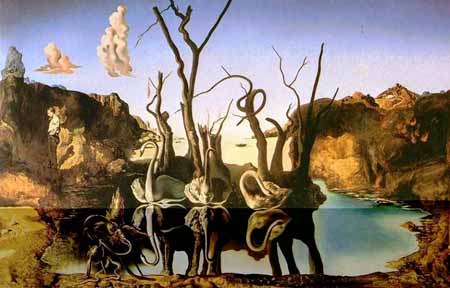
There was a vast chain of art Movements influencing Contemporary art. We still see the effect on today’s pieces of art (Figs.28-32). What is very interesting is that one art movement affected the other movement and possibly if this chain would break, by one art movement would not be therein this specific order. We would not have seen this remarkable revolutionary art, and perhaps that would affect the way we are thinking today.
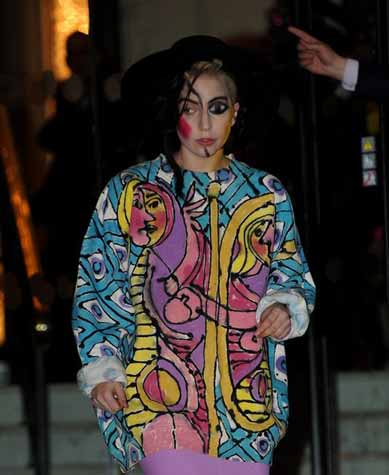
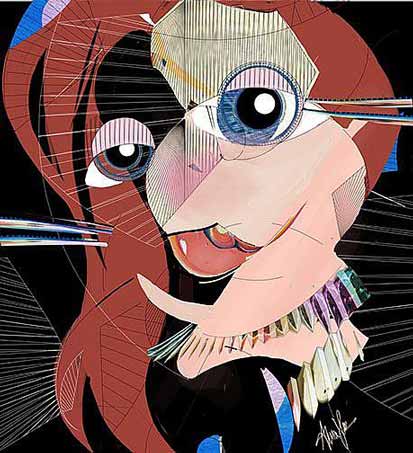
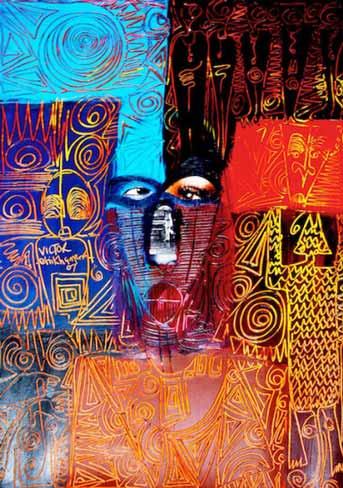
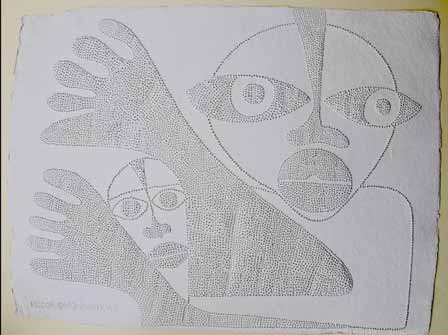
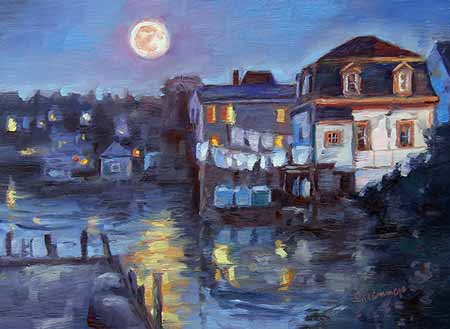
Bibliography and References
Alvarez, L., Chair, J.B., Hook, B.V., Ulloa, J., Alvarez, L., 2001. The Influence of the Mexican Muralists in the United States. From the New Deal to the Abstract Expressionism.
Andersen, J.W., Florence Griswold Museum, Guild Hall of East Hampton, 1989. En plein air: the art colonies at East Hampton and Old Lyme, 1880-1930: Florence Griswold Museum, Old Lyme, Connecticut, 20 June-30 July 1989, Guild Hall Museum, East Hampton, New York, 18 June-30 July 1989. Guild Hall of East Hampton.
BBC – Homes – Design – Arts and Crafts period styleArts and Crafts period styleModernism [WWW Document], n.d. Available from:
http://www.bbc.co.uk/homes/design/period_modernism.shtml (accessed 15.4.18).
Bohn, W., 2005. Marvelous Encounters: Surrealist Responses to Film, Art, Poetry, and Architecture. Bucknell University Press.
Breton, A., 2016. Manifesto of Surrealism. CreateSpace Independent Publishing Platform.
Chimera P., “Espana”, 2017 (Spain) Considered one of Dali’s Best Dali, http://www.dali.com, Available from: http://www.dali.com/espana-spain-considered-one-dalis-best/
Chimera P., 2016, No One Did Double-Imagery like Dali, http://www.dali.com, 2016.Dali. Available from: http://www.dali.com/no-one-double-imagery-like-dali/
Dalì symbols. What is behind them? [WWW Document], n.d. Arthive. Available from: https://arthive.com/publications/299~Dal_symbols_What_is_behind_them (accessed 9.4.18).
Dalí, S., 1998. Diary of a Genius. Creation Books.
Dali, S., 2013. The Secret Life of Salvador Dalí. Courier Corporation.
Dalí, S., Descharnes, R., 1976. Salvador Dalí, The Library of great painters. Abrams.
Dalinian symbolism [WWW Document], n.d. Espace Dalí à Montmartre. Available from: http://daliparis.com/en/salvador-dali/dalinian-symbols (accessed 16.4.18).
David Alfaro Siqueiros Biography, Art, and Analysis of Works [WWW Document], n.d. The Art Story. Available from: https://www.theartstory.org/artist-siqueiros-david-alfaro.htm (accessed 16.4.18).
De Stijl, 2018.Wikipedia. Available from: https://en.wikipedia.org/w/index.php?title=De_Stijl&oldid=837696337
Finkelstein, H., 1983. Salvador Dalí: Double and Multiple Images. American Imago 40, 311–335.
Gauss, C.E., 1949. The Aesthetic Theories of French Artists: 1855 to the Present. Johns Hopkins Press.
Greeley, R.A., 2006. Surrealism and the Spanish Civil War. Yale University Press.
Impressionism Movement, Artists and Major Works [WWW Document], n.d. The Art Story. Available from: http://www.theartstory.org/movement-impressionism.htm (accessed 16.4.18).
Information Services on Latin America (Oakland, C.., 1974. ISLA. I.S.L.A.
Kovary, Z., 2009. The Enigma of Desire: Salvador Dalí and the conquest of the irrational. PSYART – The online journal of psychology study of arts.
Mexican Muralism [WWW Document], 2014. Art History Teaching Resources. Available from: http://arthistoryteachingresources.org/lessons/mexican-muralism/ (accessed 16.4.18).
Mexican muralism, 2018.Wikipedia. Available from: https://en.wikipedia.org/w/index.php?title=Mexican_muralism&oldid=834471642
Modernism | Definition, History, & Examples [WWW Document], n.d. Encyclopedia Britannica. Available from: https://www.britannica.com/art/Modernism-art (accessed 22.4.18).
Monahan, L., 2008. Review of Surrealism and the Spanish Civil War, Robin Adèle Greeley. The Art Bulletin 90, 493–496.
Myers, B.S., 1959b. Encyclopedia of World Art. McGraw-Hill.
Oles, J., 2011. MEXICAN MURALISTS. The Museum of Modern Art.
Pablo Picasso Biography, Art, and Analysis of Works [WWW Document], n.d. . The Art Story. Available from: https://www.theartstory.org/artist-picasso-pablo.htm (accessed 17.4.18).
Pablo Picasso: 150 Famous Paintings, Biography & Quotes by Picasso [WWW Document], n.d. Available from: https://www.pablopicasso.org. URL https://www.pablopicasso.org/ (accessed 17.4.18).
Preston, P., 2007. The Spanish Civil War: Reaction, Revolution, and Revenge (Revised and Expanded Edition). W. W. Norton & Company.
Rochfort, D., 1994. Mexican Muralists: Orozco, Rivera, Siqueiros. New York: Universe.
Ross, M.E., 2003. Salvador Dalí and the Surrealists: Their Lives and Ideas, 21 Activities. Chicago Review Press.
Salvador Dalí Biography, Art, and Analysis of Works [WWW Document], n.d. The Art Story. Available from: https://www.theartstory.org/artist-dali-salvador.htm (accessed 8.4.18).
Salvador Dali, [WWW Document], n.d. Available from: http://political-analysis.org/artists/id4.html (accessed 8.4.18).
Salvador Dali: 130 Famous Paintings Analysis, Complete Works & Bio [WWW Document], n.d. Available from: https://www.dalipaintings.com. URL https://www.dalipaintings.com/ (accessed 8.4.18).
Shanes, E., 2012. The Life and Masterworks of Salvador Dalí. Parkstone International.
Soby, J.T., n.d. Salvador Dali: paintings, drawings, prints 97.
Spain, 1936-38 by Salvador Dali [WWW Document], n.d. https://www.dalipaintings.com. Available from: https://www.dalipaintings.com/spain.jsp (accessed 10.4.18).
Spain, 1938 – Salvador Dali [WWW Document], n.d. www.wikiart.org. Available from: https://www.wikiart.org/en/salvador-dali/spain-1938 (accessed 9.4.18).
Stonington Super Moon [WWW Document], n.d. reneelammers.com. Available from: http://reneelammers.com/works/2633067/stonington-super-moon (accessed 4.23.18).
Tarrant, D., n.d. Salvador Dali [WWW Document]. The Surrealists Website. Available from: http://www.surrealists.co.uk/dali.php (accessed 9.4.18).
Tate, n.d. Cubism – Art Term [WWW Document]. Tate. Available from:
http://www.tate.org.uk/art/art-terms/c/cubism (accessed 23.4.18).
Tate, n.d. Giorgio de Chirico 1888-1978 [WWW Document]. Tate. Available from: http://www.tate.org.uk/art/artists/giorgio-de-chirico-902 (accessed 5.4.18).
Tate, n.d. Modernism – Art Term [WWW Document]. Tate. Available from: http://www.tate.org.uk/art/art-terms/m/modernism (accessed 18.4.18).
Tate, n.d. Pablo Picasso 1881-1973 [WWW Document]. Tate. Available from:
http://www.tate.org.uk/art/artists/pablo-picasso-1767 (accessed 21.4.18).
Tate, n.d. Plein air – Art Term [WWW Document]. Tate. Available from:
http://www.tate.org.uk/art/art-terms/p/plein-air (accessed 22.4.18).
Tate, n.d. Post-impressionism – Art Term [WWW Document]. Tate. Available from:
http://www.tate.org.uk/art/art-terms/p/post-impressionism (accessed 23.4.18).
Term details [WWW Document], n.d. British Museum. Available from: http://www.britishmuseum.org/research/search_the_collection_database/term_details.aspx?bioId=107369 (accessed 22.4.18).
The Art Story: Modern Art Movement Timeline [WWW Document], n.d. Available from: http://www.theartstory.org/section_movements_timeline.htm (accessed 5.4.18).
The Scream, 1893 by Edvard Munch [WWW Document], n.d. https://www.edvardmunch.org. Available from: https://www.edvardmunch.org/the-scream.jsp (accessed 19.4.18).
The Spanish Civil War – Google Arts & Culture [WWW Document], n.d. Google Cultural Institute. Available from: https://artsandculture.google.com/exhibit/QRWI5SN- (accessed 7.4.18).
World War I, 2018.Wikipedia. Available from: https://en.wikipedia.org/w/index.php?title=World_War_I&oldid=837734990

37 Replies to “Salvador Dali – David Alfaro Siqueiros and the Modernist Period”
Maintain the exceptional job !! Lovin’ it!
Thank you very much!
Hi there very cool site!! Guy .. Beautiful ..
Superb .. I will bookmark your blog and take the feeds also?
I am glad to search out so many helpful information here within the put up,
we need develop extra strategies in this
regard, thanks for sharing. . . . . .
I have to thank you for the efforts you have put
in writing this site. I really hope to see the same high-grade content from you later on as well.
In fact, your creative writing abilities has inspired me to get my very
own site now 😉
Thank you very much for your great comment! keep it up!
Wow because this is excellent job! Congrats and keep it up.
Thank you very much, James. I really appreciate your comment!
Hmm it appears like your website ate my first comment
(it was extremely long) so I guess I’ll just sum it up what I
wrote and say, I’m thoroughly enjoying your blog.
I too am an aspiring blog blogger but I’m still new
to the whole thing. Do you have any suggestions for
rookie blog writers? I’d genuinely appreciate it.
I am sorry That I missed your other comment. I was away for quite a long time. Please use the contact page to email me and I will be very happy to assist you!
I do not even know how I finished up right here, but
I believed this submit was good. I don’t understand who you might be but certainly you’re going to a well-known blogger in case you aren’t
already. Cheers!
Thank you very much! I am trying my best to share whatever I Know and hopefully learn more trough you and life experience.
Very good information. Lucky me I recently found your blog
by chance (stumbleupon). I’ve book-marked it for later!
Thank you! I appreciate that!
This paragraph is in fact a nice one it assists new web visitors, who are wishing for blogging.
Thank you! I was away for a quite long time but I will come back after finishing my studies.
I used to be able to find good info from your blog posts.
I am glad that I could help! Thank you very much for your comment!
Hello all, here every one is sharing these knowledge, so
it’s good to read this blog, and I used to go to
see this weblog every day.
I appreciate this, Thank you very much!
Hey There. I discovered your weblog the usage of msn. That
is an extremely smartly written article. I will make sure to bookmark it
and come back to learn extra of your useful info.
Thanks for the post. I will definitely return.
Thank you very much for your comment. Don’t hesitate to contact me if I can help!
I am regular reader, how are you everybody? This paragraph posted at
this web page is really good.
Thank you for your comment.
Highly descriptive blog, I liked that a lot. Will there be a
part 2?
Hello And thank you very much for your comment. It is not in my plans for now but I am more than happy to help if you need any kind of info.
Hey! This is kind of off topic but I need
some guidance from an established blog. Is it hard to set up your own blog?
I’m not very techincal but I can figure things
out pretty fast. I’m thinking about creating my own but I’m not sure where to begin. Do you have any ideas or suggestions?
Cheers
nope its not too hard you just need to put a few things together and when that will happen everything else is pretty much quite simple. Please email through my contact page me and I will try to help you! Thank for your comment!
Having read this I believed it was very informative. I appreciate you finding the time and effort to put this content together. I once again find myself spending a lot of time both reading and posting comments. But so what, it was still worthwhile!
Thank you very much and I am glad I could help. For any additional info please don’t hesitate to contact me! Thank you again.stay safe!
I think the admin of this website is truly working hard in support
of his web page, for the reason that here every information is quality based data.
Thank you very much for your lovely comment. I was away for a quite long time but now I am back for more info. Thanks again!
Você realmente faz parecer tão fácil com a sua apresentação, mas eu acho isso importa ser na
verdade algo que eu acho que eu nunca entenderia. Parece-me
demasiado complexo e extremamente amplo para mim. Eu sou ansioso pelo seu próximo post, I’ll tentar pegar
o jeito!
Gracias My friend I would happy if I could help you somehow. Please don’t hesitate to contact me.
My brother suggested I might like this website.
He was entirely right. This post truly made my day.
You can not imagine just how much time I had spent for this info!
Thanks!
Thank you very much for your great comment. I am glad that I could help! Have a Great Day!
Excellent post! We are linking to this particularly great
content on our site. Keep up the great writing.
Thank you very much…I just came back from a long time break because of University! Thank you for your comment! Enjoy your day!